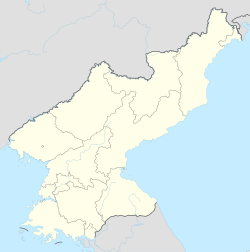Kusong
Kusong
구성시 | |
|---|---|
| Korean transcription(s) | |
| • Chosŏn'gŭl | 구성시 |
| • Hancha | 龜城市 |
| • McCune-Reischauer | Kusŏng si |
| • Revised Romanization | Guseong-si |
 Map of North Pyongan showing the location of Kusong | |
 | |
 Kusong Location within North Korea | |
| Coordinates: 39°58′N 125°10′E / 39.967°N 125.167°ECoordinates: 39°58′N 125°10′E / 39.967°N 125.167°E | |
| Country | North Korea |
| Province | North Pyongan Province |
| Administrative divisions | 24 tong, 18 ri |
| Area | |
| • Total | 666.8 km2 (257.5 sq mi) |
| Population (2008) | |
| • Total | 196,515 |
| • Dialect | P'yŏngan |
| Time zone | UTC+9 (Pyongyang Time) |
Kusŏng (Korean pronunciation: [ku.sʌŋ]) is a city in central North Pyongan province, North Korea. It borders Taegwan to the north, Taechon to the east, Kwaksan and Chongju to the south, and Chonma to the west. The highest point is (청룡산, 920 m). The year-round average temperature is 8.2 °C, with a January average of -9.6 °C and an August average of 23.3 °C. 1300 millimeters of rain fall in a typical year. 22% of the county's area is cultivated; 64% is forested.
Educational institutions located in Kusong include and Kusong Industrial College. Historical relics include the Koryo-dynasty Kuju Castle.
Industry[]
Kusong is also home to much of North Korea's military industry, with both munitions factories and uranium mines in the area.[1] The No.112, also known as the January 12th Factory was the site of the first successful Hwasong-12 launch, with a memorial dedicated to the successful launch nearby.[2]
The Panghyon airfield is also located by Kusong,[3] which is a site of missile test launches, including the first successful ICBM test launch by the DPRK.[3]
Kusong is home to the Machine Plant managed by Ho Chol Yong, a large factory that produces tracked vehicles and tanks. This factory saw multiple extensions to it in 2016 and 2020. The factories' expansion is reflected on the increasing use of tracked transporter erector launchers.[4]
Climate[]
| Climate data for Kusong (1981–2010) | |||||||||||||
|---|---|---|---|---|---|---|---|---|---|---|---|---|---|
| Month | Jan | Feb | Mar | Apr | May | Jun | Jul | Aug | Sep | Oct | Nov | Dec | Year |
| Average high °C (°F) | −1.5 (29.3) |
2.1 (35.8) |
8.2 (46.8) |
16.5 (61.7) |
22.7 (72.9) |
26.5 (79.7) |
28.0 (82.4) |
29.1 (84.4) |
25.2 (77.4) |
18.5 (65.3) |
8.1 (46.6) |
0.8 (33.4) |
15.4 (59.7) |
| Daily mean °C (°F) | −7.5 (18.5) |
−3.7 (25.3) |
2.4 (36.3) |
9.8 (49.6) |
16.1 (61.0) |
20.9 (69.6) |
23.6 (74.5) |
24.0 (75.2) |
18.8 (65.8) |
11.4 (52.5) |
2.5 (36.5) |
−4.7 (23.5) |
9.5 (49.1) |
| Average low °C (°F) | −12.7 (9.1) |
−9.1 (15.6) |
−2.9 (26.8) |
3.6 (38.5) |
10.2 (50.4) |
16.1 (61.0) |
20.2 (68.4) |
20.0 (68.0) |
13.6 (56.5) |
5.8 (42.4) |
−2.2 (28.0) |
−9.0 (15.8) |
4.5 (40.1) |
| Average precipitation mm (inches) | 11.3 (0.44) |
16.4 (0.65) |
26.2 (1.03) |
59.9 (2.36) |
82.3 (3.24) |
129.8 (5.11) |
344.7 (13.57) |
297.8 (11.72) |
87.9 (3.46) |
52.7 (2.07) |
43.6 (1.72) |
17.2 (0.68) |
1,169.8 (46.06) |
| Average precipitation days (≥ 0.1 mm) | 3.4 | 3.7 | 4.8 | 6.8 | 8.9 | 10.1 | 14.7 | 10.9 | 6.8 | 6.5 | 6.9 | 5.2 | 88.7 |
| Average snowy days | 4.7 | 3.9 | 3.1 | 0.5 | 0.0 | 0.0 | 0.0 | 0.0 | 0.0 | 0.1 | 2.0 | 4.7 | 19.0 |
| Average relative humidity (%) | 64.6 | 61.5 | 62.0 | 63.9 | 68.8 | 75.3 | 83.8 | 81.5 | 74.6 | 69.8 | 68.3 | 66.2 | 70.0 |
| Source: Korea Meteorological Administration[5] | |||||||||||||
Administrative divisions[]
The city is divided into 25 neighborhoods (dong) and 18 villages (ri).
|
|
See also[]
Footnotes[]
This article includes a list of general references, but it remains largely unverified because it lacks sufficient corresponding inline citations. (May 2017) |
- ^ Pike, John. "Kusong - North Korean Special Weapons Facilities". www.globalsecurity.org.
- ^ "Commemorating the 2017 Hwasong-12 IRBM Launch?". Beyond Parallel. 2019-06-20. Retrieved 2021-03-12.
- ^ a b Choe, Sang-hun (July 4, 2017). "North Korea Claims Success in Long-Range Missile Test". The New York Times. USA. Archived from the original on July 4, 2017. Retrieved July 4, 2017.
- ^ "New Construction Activity at the Kusong Tank Plant". www.armscontrolwonk.com. Retrieved 2021-03-12.
- ^ "30 years report of Meteorological Observations in North Korea" (in Korean). Korea Meteorological Administration. pp. 232–281. Archived from the original on 21 December 2020. Retrieved 25 December 2020.
References[]
- International Information Research Institute (국제정보연구소) (1999). "구성시". 北韓情報總覽 2000 [Bukhan jeongbo chong-ram 2000]. Seoul: Author. pp. 835–836.
- http://nk.joins.com/map/view.asp?idx=i061.htm
Further reading[]
- Dormels, Rainer. North Korea's Cities: Industrial facilities, internal structures and typification. Jimoondang, 2014. ISBN 978-89-6297-167-5
External links[]
- (in Korean) In Korean language online encyclopedias:
- City profile of Kusong
- Cities in North Pyongan
- North Korea geography stubs





